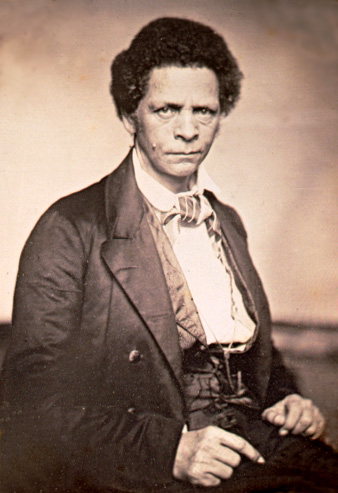|
Flag Of Liberia
The flag of Liberia or the Liberian flag, sometimes called the Lone Star, bears a close resemblance to the flag of the United States, representing Liberia's founding by former black slaves from the United States and the Caribbean. They are both a part of the stars and stripes flag family. The Liberian flag has similar red and white stripes, as well as a blue square with a white star in the canton. It was adopted on 24 August 1847. History The flag of Liberia was designed and hand-stitched by a committee of seven women. The chair of the committee was Susannah Elizabeth Lewis. The other members of the committee were Matilda Newport, Rachel Johnson, Mary Hunter, Mrs. J. B. Russwurm, Colonette Teage Ellis, and Sara Draper. All of the women were born in the United States, and many of them were wives of prominent men in Liberia. Lewis was the daughter of former vice colonial agent Colston Waring, the sister of the first First Lady of the Republic, Jane Roberts, and wife of John ... [...More Info...] [...Related Items...] OR: [Wikipedia] [Google] [Baidu] |
Liberia
Liberia (), officially the Republic of Liberia, is a country on the West African coast. It is bordered by Sierra Leone to Liberia–Sierra Leone border, its northwest, Guinea to its north, Ivory Coast to its east, and the Atlantic Ocean to its south and southwest. It has a population of around 5 million and covers an area of . English is the official language, but over 20 indigenous languages are spoken, reflecting the country's ethnic and cultural diversity. The country's capital and largest city is Monrovia. Liberia began in the early 19th century as a project of the American Colonization Society (ACS), which believed black people would face better chances for freedom and prosperity in Africa than in the United States. Between 1822 and the outbreak of the American Civil War in 1861, more than 15,000 freed and free-born black people who faced social and legal oppression in the U.S., along with 3,198 Afro-Caribbeans, relocated to Liberia. Gradually developing an Americo- ... [...More Info...] [...Related Items...] OR: [Wikipedia] [Google] [Baidu] |
Edward James Roye
Edward James Roye (February 3, 1815 – February 11, 1872) served as the fifth president of Liberia from 1870 to his overthrow in 1871 and subsequent death. He had previously served as the fourth Chief Justice of Liberia from 1865 until 1868. He was the first member of Liberia's True Whig Party to serve as president. Early life Born in 1815 in Newark, Ohio, Roye was a descendant of the Igbo people of present-day Nigeria. Emigration to Liberia In 1846, attracted by the American Colonization Society's promotion of the relocation of African Americans to the colony of Liberia in West Africa, Roye emigrated to the colony with his family at the age of 31. There he set up business as a merchant. The next year, the colony gained independence. Within three years of his arrival, Roye became active in Liberian politics, serving as a representative and speaker (1849-1850) of the Liberian House of Representatives, and as chief justice of the Supreme Court of Liberia. He was also the Sec ... [...More Info...] [...Related Items...] OR: [Wikipedia] [Google] [Baidu] |
President Of Liberia
The president of the Republic of Liberia is the head of state and government of Liberia. The president serves as the leader of the executive branch and as commander-in-chief of the Armed Forces of Liberia. Prior to the independence of Liberia in 1847, executive power in the Commonwealth of Liberia was held by the governor of Liberia, who was appointed by the American Colonization Society. The 1847 Constitution transferred the executive powers of the governorship to the presidency, which was largely modeled on the presidency of the United States. Between 1847 and 1980, the presidency was exclusively held by Americo-Liberians, the original American settlers of Liberia and their descendants. The original two-party system, with the Republican Party and the True Whig Party, ended in 1878, when the election of Anthony W. Gardiner marked the beginning of 102 years of one-party rule by the True Whigs. Following a ''coup d'état'' by disgruntled army officers led by Samuel Doe in ... [...More Info...] [...Related Items...] OR: [Wikipedia] [Google] [Baidu] |
Americo-Liberians
Americo-Liberian people or Congo people or Congau people in Liberian English,Cooper, Helene, ''The House at Sugar Beach: In Search of a Lost African Childhood'' (United States: Simon and Schuster, 2008), p. 6 are a Liberian ethnic group of African-American, Afro-Caribbean, and Liberated African descent. The sister ethnic group of Americo-Liberians are the Sierra Leone Creole people, who share similar ancestry and related culture.Liberia: History, Geography, Government, and Culture Infoplease.com Americo-Liberians trace their ancestry to free-born and formerly enslaved African Americans who emigrated in the 19th century to become the [...More Info...] [...Related Items...] OR: [Wikipedia] [Google] [Baidu] |
Caribbean
The Caribbean (, ) ( es, El Caribe; french: la Caraïbe; ht, Karayib; nl, De Caraïben) is a region of the Americas that consists of the Caribbean Sea, its islands (some surrounded by the Caribbean Sea and some bordering both the Caribbean Sea and the North Atlantic Ocean) and the surrounding coasts. The region is southeast of the Gulf of Mexico and the North American mainland, east of Central America, and north of South America. Situated largely on the Caribbean Plate, the region has more than 700 islands, islets, reefs and cays (see the list of Caribbean islands). Island arcs delineate the eastern and northern edges of the Caribbean Sea: The Greater Antilles and the Lucayan Archipelago on the north and the Lesser Antilles and the on the south and east (which includes the Leeward Antilles). They form the West Indies with the nearby Lucayan Archipelago (the Bahamas and Turks and Caicos Islands), which are considered to be part of the Caribbean despite not bordering the Caribbe ... [...More Info...] [...Related Items...] OR: [Wikipedia] [Google] [Baidu] |
.jpg)

